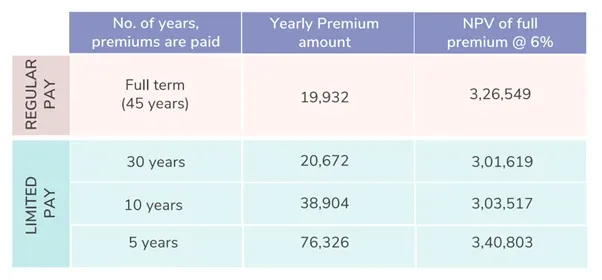Let’s imagine a scenario where you and your friend are planning vacation to Goa. It will be completely customized to where you want to go, what you want to see, the hotel you want to stay at, the restaurants and local spots you want to visit. It will be dependent on your unique set of requirements and needs, right from the mode of transport to the clothes you want to wear. Your holiday may include a day of water sports, morning runs, and romantic dinners. Her holiday may include lazing on the beach and plenty of time at the pubs and casinos.
As your holiday plan would look different from your friend's - your term insurance plan too will be unique to your family's financial situation and preferences.
You can build a customized term insurance policy that fits your needs. That’s the point of discussion in this article, as we take you through the many things you should keep in mind - while designing a perfect insurance policy that is tailor made for you and your family’s profile and needs!
Customize Term Insurance Plans
Most modern Term Insurance plans allow you to customize the policy to suit your personal preferences.
Here are the top categories that you should take note of -
- Premium Payment Frequency
- Payout Options
- Premium Pay Model
- Riders
Let’s have an indepth look at each of these!
Premium Payment Frequency
Most term insurance plans allow you to choose between payment modes based on your convenience. You can make premium payments yearly, half-yearly, quarterly, or even monthly. And, you can change your payment frequency at the time of a renewal.
There is usually a minor in the final amount that you pay. If you think you won’t be able to pay large amounts annually, you can choose the monthly payment option.
No matter which type of payment frequency you choose, remember to set up auto-debit or standing instructions so that your premiums get paid on time and your policy doesn’t lapse.
Pro Tip: Always put your standing instruction on a bank account, and not on a credit/ debit card - as the cards come with an expiry date, during which your payment might not go through smoothly.
Claim Payout Options
Insurance plans offer multiple options by which your nominee can receive the claim payout. This is one of the most important customizations that is usually missed. It basically allows you to configure how your family receives the money.
When you're not around anymore, your family will suddenly have a huge balance in their bank account, and may not be prepared to deal with that change. There have been thousands of cases, where gullible family members were persuaded to take actions that weren't exactly in their best interest.
Hence, depending on your nominee's financial aptitude, you should decide on an option of spreading out the payout into parts of a fixed amount and monthly payouts across the years.
You can choose from among the following payout options and configure how your nominee receives the claim payout -
-
Lump-sum:
It is the option where the entire claim amount is credited to the nominee’s bank account. Lump-sum is a suitable payout option when you have major loans and liabilities to be paid off.
-
Monthly income:
If you choose this option, the claim amount is paid to your family in fixed monthly installments for a certain period of time. If you don’t have any loans or liabilities - but are buying the term insurance to provide for the everyday needs of your family - this option could be beneficial.
-
Lump-sum with monthly income: This is a combination of the above two options, and extremely useful if you want a part of your claim to go towards paying off loans, and the rest be given as a monthly income for your family’s day-to-day expenses for a fixed amount of time.
Pro Tip: If your spouse or dependent is not financially well-versed, it would make sense to opt for a Lump Sum + Income Option.
Premium Pay Model
Term Insurance usually requires you to pay premiums every year until the end of the policy term. However, there are alternative ways to pay-off the premiums in shorter and faster installments.
Limited Pay is one such option that allows you to speed up your premiums in bigger installments, quickly - while enjoying the cover for a longer duration. Limited Pay is useful if -
- Want to get the payment liability off your chest quickly.
- Have, or expect to have unpredictable income in the future (eg - if you’re self-employed or a businessperson).
- Want to take an ultra long-term cover, beyond retirement age
Does Limited Pay save money?
The usual argument is that the sum of the premiums you pay in Limited Pay is lower than the aggregate premium you pay in the case of a regular payment term. But this calculation does not take into account the 'time value of money'. When we calculate the Net Present Value of the premium paid in both the cases, the answer could vary depending on the insurer and the payment term.
Let us explain with an example -
Raman is a Male, 30 year old, non-smoker who is buying a Rs. 1 Crore policy until age 75. Here is the comparison of the present value of premiums he will pay in both cases - Limited pay and Regular pay.

In this example, you'll see that the Limited Pay option is definitely better compared to Regular Pay. However, Raman only gets the maximum benefit, if he chooses the 30 year pay option or the 10 year pay option.
The bottomline is -
- Use the Limited Pay option if it is a strong preference based on your financial life. For example, if you think your business income can be very erratic in the future
- Do not blindly follow any thumb-rules. Ask your advisor to calculate NPV on the cash outlays before taking a decision.
Insurance Riders
Riders are provisions that give you an option to gain additional benefits, for your existing cover. They offer ‘ready-made’ extensions for special circumstances. Riders help you make quick and instant decisions in terms of finishing your purchase decision..
The four types of riders you’ll see commonly while buying a term insurance plan are -
- Critical illness rider
- Accidental death benefit rider
- Waiver of premium rider
- Accidental disability rider
You will find alternatives to most riders that can provide more comprehensive coverage - but, at a higher overall cost.
Like for example, the Critical Illness rider can be a cheaper alternative to a comprehensive critical illness cover which can become very expensive in the long term. However, the Rider might have limitations such as only providing a cover in case of advanced stages of the disease, etc.
You should read our detailed article on Riders before you make a decision on which Riders to pick, and which ones to skip.
Term insurance is a long-term commitment. And you’re planning this, to ensure your family’s financial security and comfort when you’re not around anymore.
We recommend that you spend adequate effort to customize the payment frequency, payout model, premium pay model, and riders - and choose a term insurance plan that is the most suitable for your family.






